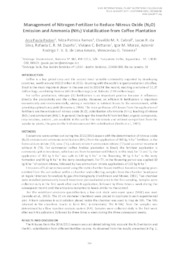Management of nitrogen fertilizer to reduce nitrous oxide (N2O) emission and ammonia (NH3) volatilization from coffee plantation.
Management of nitrogen fertilizer to reduce nitrous oxide (N2O) emission and ammonia (NH3) volatilization from coffee plantation.
Autoria: PACKER, A. P.; RAMOS, N. P.; CABRAL, O. M. R.; SILVA, L. R. da; MOLTOCARO, R. C. R.; BETTANIN, V. C.; MORASI, I. M.; AMARO, A. R. F. V. B. de L.; TEIXEIRA, W. G.
Resumo: Coffee is a key global crop and the second most valuable commodity exported by developing countries, worth around US$19 billion in 2015. Counting with the world\s largest production of coffee, Brazil is the most important player in the area and in 2016 hit the record, reaching a volume of 51.37 million bags, combining Arabica (43.24 million bags) and Robusta (7.98 million bags). For coffee production, nitrogen (N) fertilization is an important practice because it influences directly the productivity and the coffee quality. However, an efficient N fertilization is important economically and environmentally, aiming a reduction in nutrient losses to the environment, while providing optimal crop yield. The main pathways of N losses from the application of fertilizers are the emission of nitrous oxide (N2O), volatilization of ammonia (NH3), leaching of nitrate (NO3 -) and ammonium (NH4 +). In general, the longer the time the N from fertilizer, organic compounds, crop residues, and etc., are available in the soil for the microbiota and without competition from the uptake by plants, the greater the N2O emission and NH3 volatilization. In this work, evaluations were carried out during the 2015/2016 season with the determination of nitrous oxide (N2O) emission and ammonia volatilization (NH3) from the application of 300 kg N ha-1 fertilizer, in the form calcium nitrate (T2), urea (T5), calcium nitrate + ammonium nitrate (T7) and a control treatment without N (T8).
Ano de publicação: 2017
Tipo de publicação: Artigo em anais e proceedings
Unidade: Embrapa Meio Ambiente
Palavras-chave: Ammonia, Amônia, Café, Emissão de gases, Fertilizante nitrogenado, Fertilizer losses, Gas emissions, Nitrogen fertilizers, Nitrogênio, Nitrous oxide, Óxido nitroso
Observações
1 - Por padrão são exibidas publicações dos últimos 20 anos. Para encontrar publicações mais antigas, configure o filtro ano de publicação, colocando o ano a partir do qual você deseja encontrar publicações. O filtro está na coluna da esquerda na busca acima.
2 - Para ler algumas publicações da Embrapa (apenas as que estão em formato ePub), é necessário ter, no celular ou computador, um desses softwares gratuitos. Sistemas Android: Google Play Livros; IOS: iBooks; Windows e Linux: software Calibre.
Acesse outras publicações
Acesse a Base de Dados da Pesquisa Agropecuária (BDPA) para consultar o acervo completo das bibliotecas da Embrapa.

